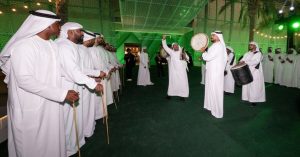The 17th edition of Abu Dhabi Art recently concluded, marking a pivotal moment for the region’s art scene as it prepares for its transformation into Frieze Abu Dhabi in 2026. This year’s fair was the largest to date, attracting a diverse array of local Emirati and international buyers, curators, and art enthusiasts. The event underscored the growing importance of the Gulf region as a significant hub for artistic expression and commerce. The sheer scale of participation, with 142 exhibitors from 37 countries, clearly signifies a rising global interest in the art market centered in the UAE’s capital.
A Record-Breaking Abu Dhabi Art: A Prelude to Frieze
The recent Abu Dhabi Art fair, held from November 18th to 23rd, built on years of steady growth. This edition was particularly noteworthy, boasting a considerable increase in exhibitors compared to the 100+ seen the previous year. The enthusiastic response from both seasoned collectors and new patrons has solidified Abu Dhabi’s position as a premier destination for art acquisition and appreciation. Dyala Nusseibeh, the director of Abu Dhabi Art since 2016, emphasized the broadening appeal of the fair to a wider range of buyers, including a flourishing middle-tier demographic.
International Galleries & Rising Market Demand
A key indicator of this rising demand was the presence of 53 new exhibitors, including prominent international galleries like Pace. Pace’s return, for the first time since 2011, highlighted a renewed commitment to the Gulf region. They showcased a small-edition sculpture by Robert Indiana, the iconic “Love,” priced at $850,000, and new sculptural pieces by Arlene Shechet at $120,000, demonstrating a willingness to bring high-value pieces to the burgeoning market.
Similarly, Galleria Anna Marra from Rome marked its first appearance, presenting works by Italian, Moroccan, and South African artists – Veronica Botticelli, Khadija Jayi, and Turiya Magadlela, respectively, with price points accessible to a broader audience (under $11,500). Anna Marra noted her eagerness to engage with the Gulf market, and was pleasantly surprised by the cultural vibrancy she discovered in Abu Dhabi. This sentiment was echoed by others, showcasing how the fair is actively shaping perceptions and attracting new players. The increased interest across various price points is vital for the sustained growth of the art market in the UAE.
Focusing on Emerging Artistic Voices
This edition of Abu Dhabi Art placed a deliberate “Focus” on art from Nigeria and Turkey, offering a platform for artists and galleries from these regions to gain international exposure. The inclusion of Nigeria’s Osogbo School was particularly impactful, strengthening the fair’s commitment to showcasing art from historically underrepresented regions. Nusseibeh stressed the importance of diversity in the art presented, reflecting a broader trend toward inclusivity within the global art world. This strategic focus provides opportunities to discover unique artistic expressions and encourages cross-cultural dialogue.
The Shift to Frieze Abu Dhabi: An Evolution, Not a Revolution
The upcoming transition to Frieze Abu Dhabi in 2026 is being framed not as a complete overhaul, but as a natural “evolution” of the fair. Abu Dhabi Art itself has a history of transformation, originating as ArtParis Abu Dhabi in 2007 and subsequently becoming the Abu Dhabi Art Fair under the auspices of the Abu Dhabi Authority for Culture and Heritage (ADACH) in 2009. The partnership with Frieze – a globally renowned art fair brand – is expected to further elevate Abu Dhabi’s profile as a leading cultural destination and attract even more participation from top-tier galleries and collectors.
High-Value Sales and the Rise of Regional Collectors
The fair witnessed several significant sales, including a rare “First Folio” edition of Shakespeare’s plays, sold by Peter Harrington Rare Books for approximately $4.5 million to an international collector. This sale underscored the demand for unique and historically important artworks within the region.
However, the most encouraging trend was the growing presence of local collectors. Maryam Falasi, founder and director of Iris Projects, observed a “new wave of institutional curators” and a genuinely optimistic atmosphere. Her gallery successfully sold works by local Emirati artists Shamsa Al Omaira (three pieces at $10,000 each) and Juma Al Haj (one piece for $16,000 to a corporate collection). Falasi highlighted the enthusiasm of local collectors and the community’s dedication to supporting regional talent, alongside a growing appetite for emerging artists. This demonstrates a maturing art collecting scene within the UAE.
Abu Dhabi Art Week: A Flourishing Cultural Ecosystem
This year’s Abu Dhabi Art unfolded amidst a particularly vibrant “Art Week” in the capital. The inaugural Nomad Abu Dhabi, dedicated to collectible design and contemporary art, ran concurrently. The highly anticipated opening of the National History Museum Abu Dhabi on November 22nd, and the upcoming launch of the Zayed National Museum on December 3rd, further contributed to the cultural buzz. Numerous new gallery openings and exhibitions across the city showcased the UAE capital’s flourishing artistic landscape.
Sustaining Growth in a Competitive Landscape
The emergence of Abu Dhabi Art and the planned Frieze Abu Dhabi, alongside events like Art Basel Qatar (launching in February 2026), raises the question of whether the Gulf region can sustain such a concentration of high-profile art fairs. Nusseibeh remains confident, pointing to the region’s high GDP and the increasing disposable income of its population. She believes “the time is just right” for continued growth and investment in the arts. The key will be fostering a diverse and engaged collecting base, and continuing to champion both regional and international artistic voices.


